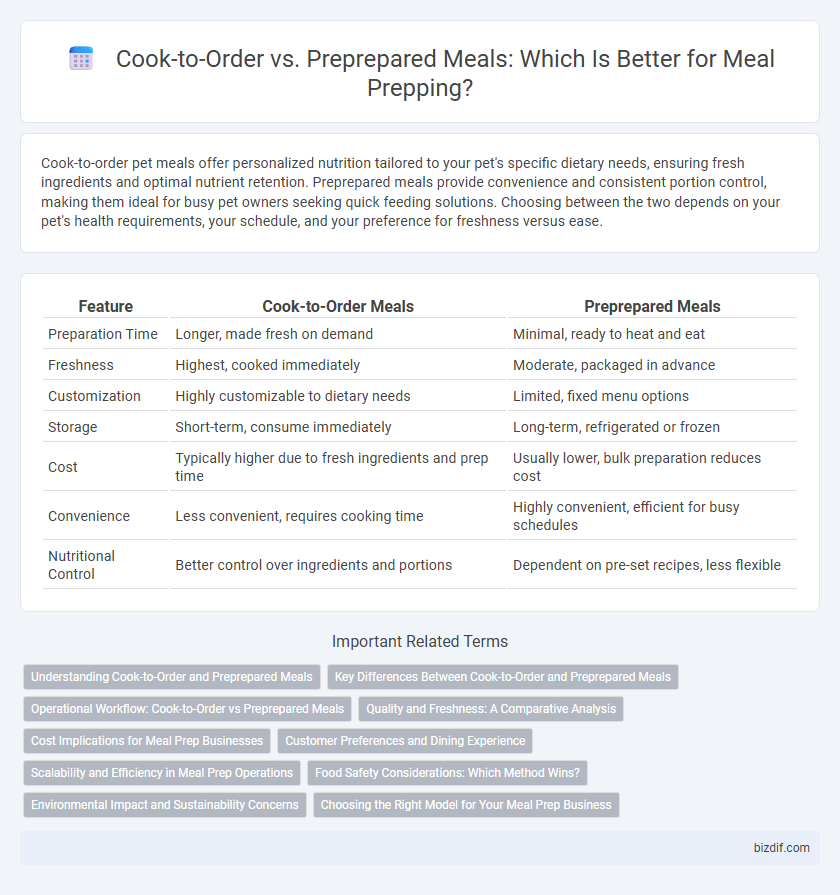Cook-to-order pet meals offer personalized nutrition tailored to your pet's specific dietary needs, ensuring fresh ingredients and optimal nutrient retention. Preprepared meals provide convenience and consistent portion control, making them ideal for busy pet owners seeking quick feeding solutions. Choosing between the two depends on your pet's health requirements, your schedule, and your preference for freshness versus ease.
Table of Comparison
| Feature | Cook-to-Order Meals | Preprepared Meals |
|---|---|---|
| Preparation Time | Longer, made fresh on demand | Minimal, ready to heat and eat |
| Freshness | Highest, cooked immediately | Moderate, packaged in advance |
| Customization | Highly customizable to dietary needs | Limited, fixed menu options |
| Storage | Short-term, consume immediately | Long-term, refrigerated or frozen |
| Cost | Typically higher due to fresh ingredients and prep time | Usually lower, bulk preparation reduces cost |
| Convenience | Less convenient, requires cooking time | Highly convenient, efficient for busy schedules |
| Nutritional Control | Better control over ingredients and portions | Dependent on pre-set recipes, less flexible |
Understanding Cook-to-Order and Preprepared Meals
Cook-to-order meals are freshly prepared upon request, ensuring customized flavors and optimal temperature at serving time. Preprepared meals, also known as ready-made or pre-cooked meals, are cooked in advance and stored for quick reheating, offering convenience and consistent portion control. Understanding the differences helps consumers choose between freshness and time-saving attributes based on their lifestyle needs.
Key Differences Between Cook-to-Order and Preprepared Meals
Cook-to-order meals are freshly prepared upon request, ensuring maximum freshness, customization, and control over ingredients, often resulting in superior taste and nutritional quality. Preprepared meals are mass-produced, packaged in advance, and designed for convenience and longer shelf life but may contain preservatives and lack the personalized touch of cook-to-order dishes. The key differences revolve around freshness, customization options, cooking time, and ingredient control, affecting overall flavor profiles and health benefits.
Operational Workflow: Cook-to-Order vs Preprepared Meals
Cook-to-order workflows require real-time ingredient assembly and cooking, demanding skilled staff and flexible kitchen setups to manage varying order volumes efficiently. Preprepared meals streamline the operational process by enabling bulk cooking and standardized portioning, reducing wait times and minimizing labor costs. Implementing preprepared meals enhances inventory control and consistency but may sacrifice customization and freshness compared to cook-to-order models.
Quality and Freshness: A Comparative Analysis
Cook-to-order meals ensure optimal freshness and retain high nutritional quality by being prepared immediately before consumption, reducing nutrient loss that often occurs during storage. Preprepared meals offer convenience but may experience decreased quality due to reheating processes, which can alter texture and flavor and potentially degrade heat-sensitive vitamins. Consumers prioritizing superior taste and maximum nutrient retention typically prefer cook-to-order options, while preprepared meals suit those valuing time efficiency.
Cost Implications for Meal Prep Businesses
Cook-to-order meals often result in higher labor and ingredient costs due to the need for fresh preparation and customized orders, impacting overall profitability for meal prep businesses. Preprepared meals benefit from bulk purchasing and streamlined production processes, significantly reducing per-unit costs and enabling competitive pricing. Balancing these cost implications is crucial for meal prep businesses aiming to optimize operational efficiency and maintain customer satisfaction.
Customer Preferences and Dining Experience
Customer preferences in meal prepping often lean toward cook-to-order options for fresher taste and the ability to customize ingredients. Preprepared meals offer convenience and time-saving benefits, appealing to those with busy schedules or limited cooking skills. The dining experience varies as cook-to-order meals provide a sense of freshness and personalization, while preprepared meals prioritize efficiency and consistent portion control.
Scalability and Efficiency in Meal Prep Operations
Cook-to-order meal prep offers high customization and freshness but struggles with scalability due to longer preparation times and labor demands. Preprepared meals enhance efficiency by enabling batch cooking, reducing labor costs, and standardizing portion control, which supports large-scale distribution. Operations focused on volume growth and resource optimization benefit more from preprepared meal systems.
Food Safety Considerations: Which Method Wins?
Cook-to-order meals provide superior food safety by minimizing the time food spends in the temperature danger zone, reducing bacterial growth risk. Preprepared meals require rigorous refrigeration and reheating protocols to prevent contamination and ensure safety. Therefore, cook-to-order methods often win in maintaining optimal food safety standards due to immediate preparation and consumption.
Environmental Impact and Sustainability Concerns
Cook-to-order meals typically generate less food waste compared to preprepared meals, as portions are tailored to immediate demand, reducing overproduction. Preprepared meals often require extensive packaging and refrigeration, increasing their carbon footprint and environmental impact. Sustainable meal prep practices prioritize minimizing packaging waste and optimizing ingredient use to promote eco-friendly consumption.
Choosing the Right Model for Your Meal Prep Business
Selecting the ideal model for your meal prep business involves weighing cook-to-order against preprepared meals based on freshness, customization, and operational efficiency. Cook-to-order meals offer high personalization and freshness, appealing to health-conscious customers but require more kitchen resources and longer prep times. Preprepared meals provide scalability and convenience, reducing labor costs while ensuring consistent portions, making them suitable for businesses targeting quick service and volume.
Cook-to-Order vs Preprepared Meals Infographic

 bizdif.com
bizdif.com